
Taking your dog training business online might seem hard to imagine, but even before the pandemic, some trainers were doing it successfully. Far from being a last resort, there are advantages for trainers, clients, and dogs. Here’s how to succeed.
The Learning Environment
Working in the home environment can be a big positive for dogs.
“I have found that dogs are less distracted when working in their home environment. Foundations are learnt quicker in general,” says Laura Ryder, head trainer at Morley Vet Centre in Perth, Western Australia.
Jessica Ring, a Fear Free certified trainer in Maryland who recently started teaching group classes online, cautions that there are some exceptions. For clients with chaotic homes, the class environment was less distracting. And as students become more advanced, creating training distractions at home can become more challenging. But in general Ring finds it’s a positive: “It seems like dogs are getting through the material more quickly in the session.”
Ring has also observed that without the distraction and stimulation of other people and dogs, it’s possible for students and dogs to take a real break when she’s focused on someone else. “Especially for little dogs, they don’t fill up as quickly if they can take a break,” she says.
Fear Free certified trainer Kate LaSala says some kinds of training, such as for separation anxiety, have long been done remotely. It also has advantages for fear and aggression cases. “Often, with aggression, it’s less stressful for the dog not to have a stranger there,” she says. “If I’m dealing with a stranger-danger case, the fact that I’m going there to talk to the person automatically brings that dog over threshold in most cases. It makes the dog anxious, makes the person anxious, makes me anxious.” Online consultations eliminate all of that and are no obstacle to the work she needs to do.
“A big part of what I do in fear and aggression cases is educating and coaching the client. If the dog is a stranger-danger case, I’m not going to be hands-on anyway.”
Online training has the same advantages for dogs with similar but less extreme issues. “I’ve had some people take online classes who probably couldn’t bring a dog to a group class,” says Ring. “Dogs who are reactive to other dogs, excited, or worried can participate.”
Client Convenience
LaSala finds that online training has advantages for scheduling, since she no longer must factor in commuting time or setting up and cleaning a facility. “I can accommodate appointment times I’d never do before,” she says. “Eight a.m. on Saturday — that was not going to happen. But I can do that remotely, and I can accommodate much later appointment times, too.”
For the same reasons, Ring can offer shorter sessions and single-session classes. “I only have to commit to half an hour when I can fit it in,” she says. She now offers 30-minute classes, including basic skills and tricks. “Some of them are to jump-start people in their training and give them an idea of what it would be like to work this way,” she says. She still offers standard hour-long classes as well, but it’s useful for clients have more options. “It’s a lot for people and dogs to stay focused for that long, so the half hour is enough for some people,” she says.
Another benefit of online training is that platforms such as Zoom allow sessions to be recorded. LaSala makes the video available to clients. “If they want to be able to refer back to our session, they can do that, unlike an in-person session, which is fleeting,” she says.
Business Considerations
LaSala finds that a benefit of taking her business online is that she can take on more work. “I can fit more clients into a day because I’m not spending hours commuting between appointments,” she says. Partly due to this, she has reduced her fees for sessions. “Because I’m not spending money buying cheese and steak and hot dogs, and with the time and money I’m saving not having to commute, I roll that into my price, so it is less expensive,” she says.
Not all trainers have made the same calculation about fees. Ring says that although she is saving commuting and setup/cleanup time, she finds that she spends more time communicating with clients between sessions, so thinks it evens out.
A new challenge can be attracting business in the first place. “How to market to this new audience is still something I’m trying to figure out,” says Ring. She’s starting to get clients from farther away than in the past, but she sees a new need to educate potential clients.
“This is a shift for people, to get over the traditional thinking that the dog trainer needs to come and work with the dog,” says LaSala. “Once they’re on board, everyone loves it – it’s cost-effective, it’s less stressful, we can get the same results – but now there’s an extra step where you need to sell the person on the idea of how this is going to be effective and efficient.”
LaSala has pages on her website explaining procedures: what an initial consult consists of, what remote learning looks like, how to prepare for a session. Much of this hasn’t changed. An initial consult is still two hours of talking. And training a dog who’s fearful on walks, for instance, involves instilling a number of behaviors at home before taking them on the road – just like before, except now she needs to explain in advance that she doesn’t need to be there for the walk. “It’s a lot of dispelling preconceived notions of what the owner thinks dog training looks like,” she says. “I don’t need to see your dog be afraid outside. I know what that looks like, I don’t need you to show me that.”
Along with clearly explaining procedures on your website, don’t forget the power of online reviews.
“A couple of well-written testimonials from clients, I feel, are the best way to convince other dog owners that online learning is effective and worthwhile,” says Ryder.
One of hers reads in part: “I honestly wasn’t sure how online training would work for me, but it really was a wonderful experience. Participating in dog training has always been a bit of an outlet for me, especially when the rest of life can get so crazy and busy. Now more than ever, to feel connected and supported by such wonderful dog professionals does wonders for your own wellbeing as well as your dog’s.”
This article was reviewed/edited by board-certified veterinary behaviorist Dr. Kenneth Martin and/or veterinary technician specialist in behavior Debbie Martin, LVT.
Linda Lombardi writes about the animals that share our planet and our homes for magazines including The Bark, websites including National Geographic and Mongabay.com, and for the Associated Press. Her most recent book, co-authored with Deirdre Franklin, is The Pit Bull Life: A Dog Lover’s Companion.
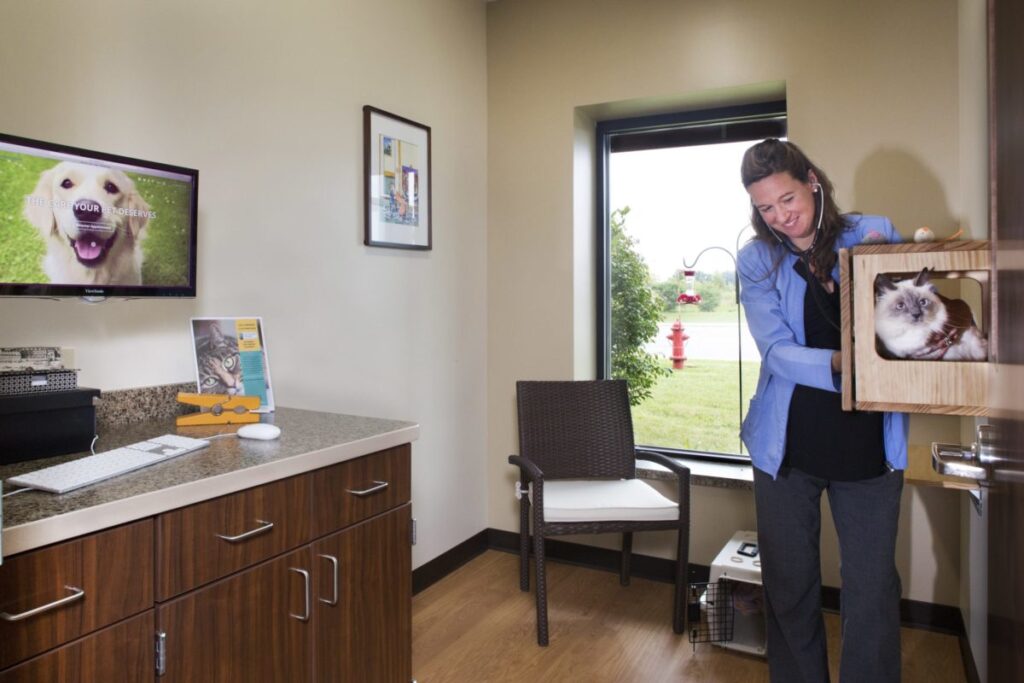
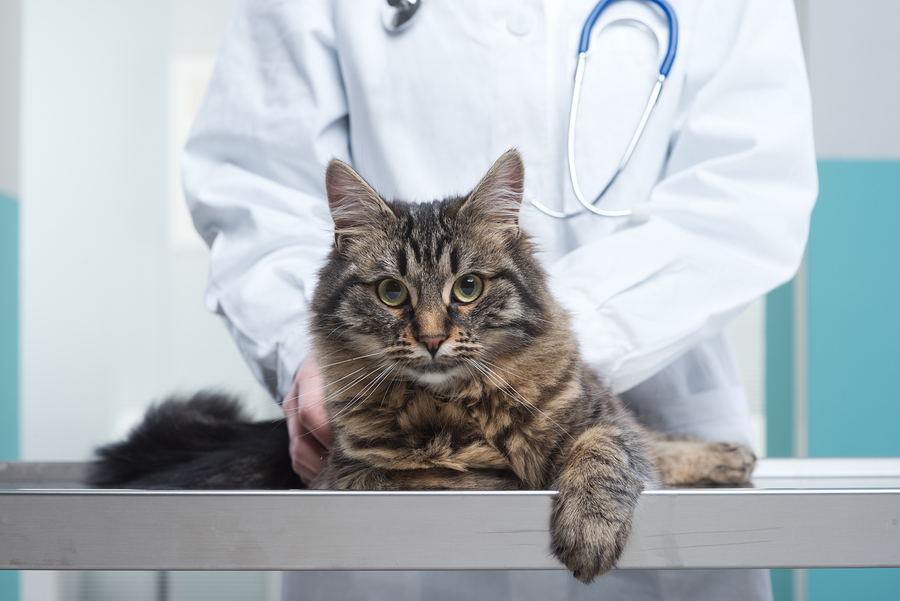
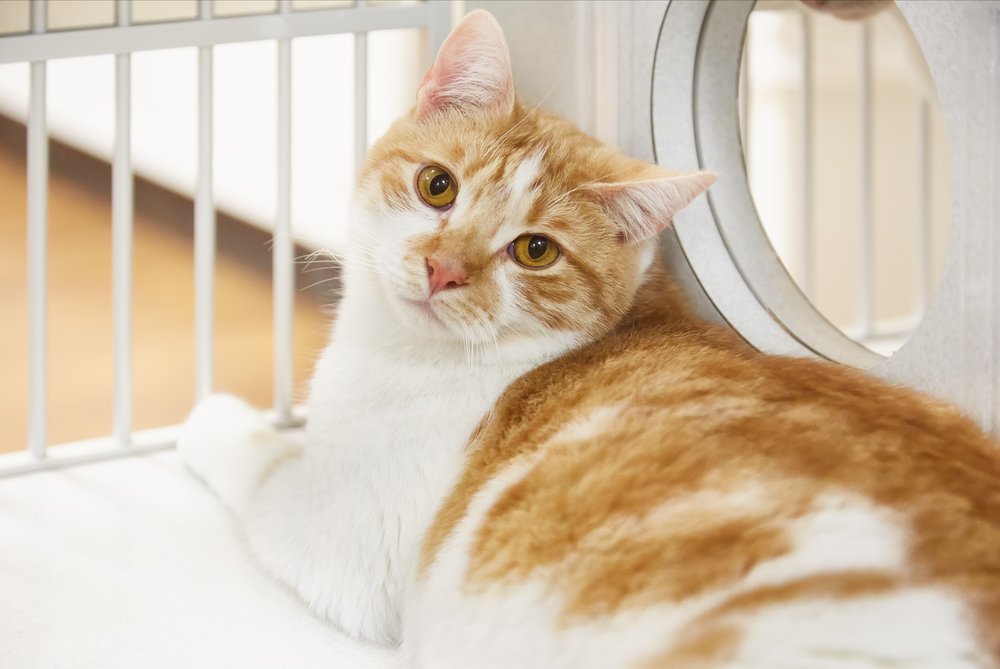
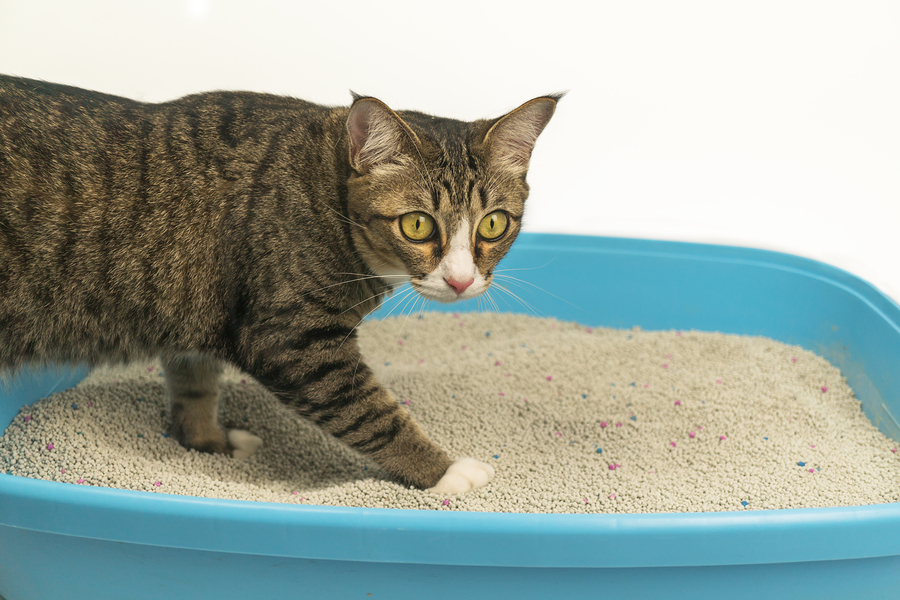

 year I’ve raised a pup following Summit’s training guidelines based on positive reinforcement and what puppies can handle at each developmental stage. Each pup explores the world in tiny increments based on what they tell me through body language about how the new environment feels to them. Sometimes we don’t even get out of the car if the pup seems to be hesitant. If they’re not ready for a new place, we go somewhere they have already been to build confidence. Each pup is born with unique strengths and levels of confidence. The big and bold ones move through environments more quickly than timid pups. My current pup, Jazz, came to me at 11 months of age. She was timid about change, so we moved slowly and calmly. We joined a scent work class, which allows the dogs to move freely at their own pace. This built her confidence quickly and now she rocks in almost any setting. Watching what your pet tells you through body language (relaxed, happy, withdrawn, cowering) is key to a truly Fear Free companion.
year I’ve raised a pup following Summit’s training guidelines based on positive reinforcement and what puppies can handle at each developmental stage. Each pup explores the world in tiny increments based on what they tell me through body language about how the new environment feels to them. Sometimes we don’t even get out of the car if the pup seems to be hesitant. If they’re not ready for a new place, we go somewhere they have already been to build confidence. Each pup is born with unique strengths and levels of confidence. The big and bold ones move through environments more quickly than timid pups. My current pup, Jazz, came to me at 11 months of age. She was timid about change, so we moved slowly and calmly. We joined a scent work class, which allows the dogs to move freely at their own pace. This built her confidence quickly and now she rocks in almost any setting. Watching what your pet tells you through body language (relaxed, happy, withdrawn, cowering) is key to a truly Fear Free companion. store when she was three months old. Early veterinary visits had caused her to become fearful. Medication didn’t help and she required heavy restraint. Her pet parents called our clinic about taking her on as it had been suggested that she might prefer a female veterinarian.
store when she was three months old. Early veterinary visits had caused her to become fearful. Medication didn’t help and she required heavy restraint. Her pet parents called our clinic about taking her on as it had been suggested that she might prefer a female veterinarian.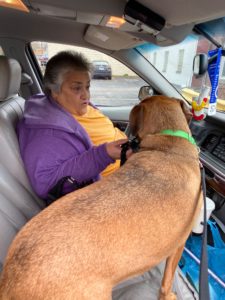 Canasta is fearful of strangers and handling, which makes veterinary visits difficult for both Canasta and her caregiver. I recently started working with Canasta on basket muzzle training and being more comfortable with strangers, but she was in need of bloodwork immediately. Her veterinarian prescribed pre-visit pharmaceuticals, and I worked with the technician to create a handling plan and came to the visit to assist. When Canasta walked in wearing her basket muzzle, I used gentle control to restrain her while the technician drew blood. Canasta even took a treat from the technician when we were done, which is a huge win! Her mother was crying, knowing her dog did so well, and I will continue to work on cooperative care with the caregiver and Canasta.
Canasta is fearful of strangers and handling, which makes veterinary visits difficult for both Canasta and her caregiver. I recently started working with Canasta on basket muzzle training and being more comfortable with strangers, but she was in need of bloodwork immediately. Her veterinarian prescribed pre-visit pharmaceuticals, and I worked with the technician to create a handling plan and came to the visit to assist. When Canasta walked in wearing her basket muzzle, I used gentle control to restrain her while the technician drew blood. Canasta even took a treat from the technician when we were done, which is a huge win! Her mother was crying, knowing her dog did so well, and I will continue to work on cooperative care with the caregiver and Canasta.

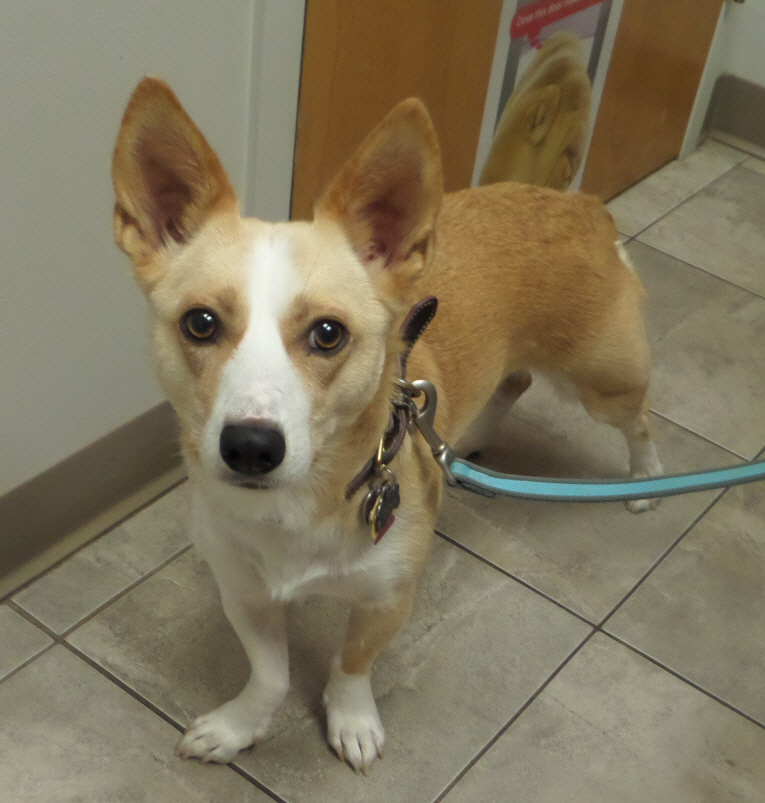
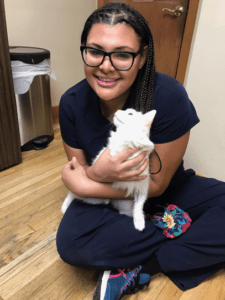 veterinarian, Dianicia Kirton, DVM, whose Hopkinton, Massachusetts, practice is Fear Free certified, has been recommending that Sushi get her teeth cleaned but my sister was hesitant. The veterinarian addressed each of her concerns until eventually she was ready to move forward. A few weeks later, Sushi’s mom brought her in for the teeth cleaning, although she was still nervous and reluctant. The veterinarian and staff were very calming and worked on Sushi quickly. Everything went well, and Sushi was her normal, happy self afterward. My sister told the vet that she felt like she had been “Fear Freed,” and Dr. Kirton responded, “Yes, it’s as much for the people as it is for the animals.” My sister was happy with the whole experience and thankful to have found a practice that uses these methods!
veterinarian, Dianicia Kirton, DVM, whose Hopkinton, Massachusetts, practice is Fear Free certified, has been recommending that Sushi get her teeth cleaned but my sister was hesitant. The veterinarian addressed each of her concerns until eventually she was ready to move forward. A few weeks later, Sushi’s mom brought her in for the teeth cleaning, although she was still nervous and reluctant. The veterinarian and staff were very calming and worked on Sushi quickly. Everything went well, and Sushi was her normal, happy self afterward. My sister told the vet that she felt like she had been “Fear Freed,” and Dr. Kirton responded, “Yes, it’s as much for the people as it is for the animals.” My sister was happy with the whole experience and thankful to have found a practice that uses these methods! Pennie, a 7-year-old 78-pound Chesapeake Bay Retriever, had never had a full veterinary exam after her puppy vaccines because she bared her teeth and growled at veterinary team members at every clinic she was taken to. When she was brought to us, we implemented several Fear Free strategies, spending 45 minutes building her trust both outside the clinic and in the exam room. We were able to get her to stand on the lift table and receive vaccinations without being muzzled. On her third visit, we were able to lift her lips and examine her teeth. Now she boards with us routinely and is a big part of our veterinary practice family. Implementing these Fear Free tools has changed Pennie’s life and her owner is now able to better understand and relate to her dog, making it much safer to take her for walks and be groomed.
Pennie, a 7-year-old 78-pound Chesapeake Bay Retriever, had never had a full veterinary exam after her puppy vaccines because she bared her teeth and growled at veterinary team members at every clinic she was taken to. When she was brought to us, we implemented several Fear Free strategies, spending 45 minutes building her trust both outside the clinic and in the exam room. We were able to get her to stand on the lift table and receive vaccinations without being muzzled. On her third visit, we were able to lift her lips and examine her teeth. Now she boards with us routinely and is a big part of our veterinary practice family. Implementing these Fear Free tools has changed Pennie’s life and her owner is now able to better understand and relate to her dog, making it much safer to take her for walks and be groomed.
 We love our Fear Free veterinary hospital. At TLC, there are separate areas for cats and dogs. We took our two cats in last week, and the exam room was comfortable, with shelves for the cats to explore. A board listed the names of the technician and veterinarian who would be seeing the cats, so we knew who would be treating them. The technician who went over the intake information was sweet and tender with Lucy and Lilu. An email ahead of time alerted us that a new veterinarian would be seeing the cats. She was calm and handled the cats gently. Both cats were calm throughout the visit—although Lucy didn’t much like having her teeth examined—and when they got home they came out of their carriers calmly and went about their day. Lilu was her regular self and didn’t hide away as she has on some prior visits to other clinics. The clinic called the next day to see how the cats reacted to their vaccines and visit. We feel we have found our new clinic!
We love our Fear Free veterinary hospital. At TLC, there are separate areas for cats and dogs. We took our two cats in last week, and the exam room was comfortable, with shelves for the cats to explore. A board listed the names of the technician and veterinarian who would be seeing the cats, so we knew who would be treating them. The technician who went over the intake information was sweet and tender with Lucy and Lilu. An email ahead of time alerted us that a new veterinarian would be seeing the cats. She was calm and handled the cats gently. Both cats were calm throughout the visit—although Lucy didn’t much like having her teeth examined—and when they got home they came out of their carriers calmly and went about their day. Lilu was her regular self and didn’t hide away as she has on some prior visits to other clinics. The clinic called the next day to see how the cats reacted to their vaccines and visit. We feel we have found our new clinic! reactive. During her first appointment she was quite nervous, but with the help of some peanut butter as a distraction she allowed us to pet her. We decided that that was a win and that Zola would benefit from coming back another time after having gabapentin to help calm her. At her next visit, Zola was visibly more relaxed, and we had a Kong full of peanut butter ready for her. Knowing that Zola did better with minimal restraint we kept her focused on the Kong and were able to do a full exam, vaccinations and a blood draw. Zola’s owners had never seen her so relaxed at the vet and she has since come back willing and happy to see us.
reactive. During her first appointment she was quite nervous, but with the help of some peanut butter as a distraction she allowed us to pet her. We decided that that was a win and that Zola would benefit from coming back another time after having gabapentin to help calm her. At her next visit, Zola was visibly more relaxed, and we had a Kong full of peanut butter ready for her. Knowing that Zola did better with minimal restraint we kept her focused on the Kong and were able to do a full exam, vaccinations and a blood draw. Zola’s owners had never seen her so relaxed at the vet and she has since come back willing and happy to see us.